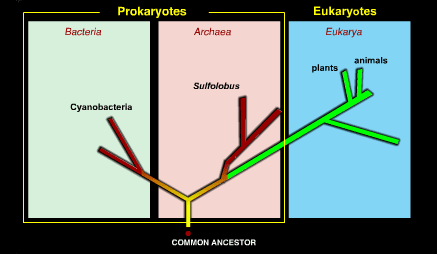
|
Lobby > Exhibits > Hot Spring Ecology > Microbes > The Tree of Life MicrobesTHE TREE OF LIFE Life on our planet comes in many shapes and sizes-ranging from the familiar to the bizarre. For centuries, scientists divided the living organisms into two groups-plants and animals. During the last century, scientists have reconsidered how Earth's life forms should be grouped. In part because of discoveries made in Yellowstone, scientists have proposed a "Tree of Life" that divides all living things into three separate branches or domains, Eukarya, Bacteria, and Archaea. Plants and animals are now only allotted a small space in Domain Eukarya.  The Tree of Life is based on differences in DNA, or deoxyribonucleic acid, and each domain represents life forms that are fundamentally different from those in the other two. Scientists think the prokaryotic organisms that comprise Domains Archaea and Bacteria shared common ancestry billions of years ago and were likely the earliest life forms on the Earth. Domain Eukarya branched off from Archaea. Scientists have proposed that the most primitive life forms and the descendents of Earth's earliest organisms would be found in environments similar to those that existed on a young, hot planet. The "universal ancestor" to all life on Earth may exist in the hydrothermal areas of Yellowstone. Next | 1 > 2 > 3 > 4 > 5 > 6 > 7 > 8 | Return to: Hot Spring Ecology |
|
||||||||||||||||||||||||||||||

